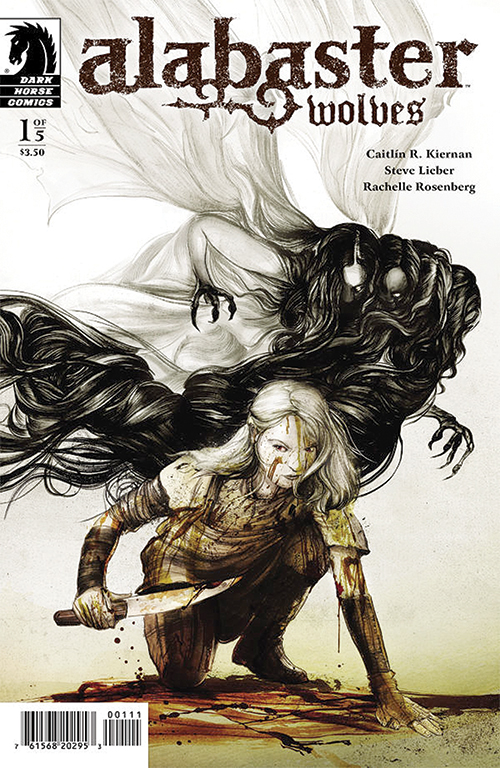It’s tough to remember the last time werewolves were scary. In their recent incarnations in popular films and TV shows like the Twilight saga and True Blood, werewolves are merely computer-generated beasts growling and snapping their jaws, biding their time until they get the chance to morph back into their default form of shirtless beefcake.
Behold a pale horse

It’s tough to remember the last time werewolves were scary.
In their recent incarnations in popular films and TV shows like the Twilight saga and True Blood, werewolves are merely computer-generated beasts growling and snapping their jaws, biding their time until they get the chance to morph back into their default form of shirtless beefcake.
The savage, lethal werewolves of old once again take center stage in a new graphic novel from Milwaukie’s own Dark Horse Comics.
Alabaster: Wolves, written by Caitlin R. Kiernan and drawn by Steve Lieber (who resides in Portland as part of Periscope Studio), tells the story of a young girl named Dancy Flammarion, fighting alone in a world of monsters.
Armed with only a knife and her wits, Dancy walks into a deserted South Carolina town at the bidding of a monstrous four-headed angel only she can see.
Kiernan has previously written two prose novels starring Dancy, but prior knowledge of those works is unnecessary.
The fantastic first chapter thrusts us into Dancy’s world with enough information to form an image of the world and her character, but stops short of holding our hands or dumping a few paragraphs onto a recap page.
Dancy herself is an uncommon animal. Putting a 16-year-old heroine in a supernatural setting conjures a set of expectations, which Dancy seems happy to shatter.
An albino with little to no sign of any budding sexuality, Dancy would sooner spit in your mouth than be caught trying to fit her boobs and butt in the same frame, like so many other women in superhero comics. This scrappy determination is betrayed, however, by some serious baggage that has to be dealt with before the story ends.
From the start, the sharp narration and dialogue endears the main character to the audience. Dancy speaks with a Southern drawl—she’s particularly fond of the word “ain’t”—but proves to be quick on the draw in conversation.
The bulk of the first chapter depicts a simple chat between Dancy and another girl named Maisie, who meet at what looks like a post-apocalyptic bus stop.
Tension begins building immediately as the two size each other up: Maisie is a werewolf, to be sure, and Dancy is the kind of girl that kills werewolves. As the two bat words back and forth, the simmering inevitability of violence approaches a boil.
Instead of a brawl, they agree on a classic game of questions, with lives at stake. In the wrong hands, starting off a book with a lengthy conversation and the trope of a riddle battle would have been a death sentence.
But Kiernan handles it in a way that propels the reader forward through the rest of this action-packed book.
That’s not to say that Lieber doesn’t do a fair share of the heavy lifting. He applies a rough, gritty style to the setting and characters that distinguish the book from the sanitized worlds of modern horror.
It’s a tall order to make several pages of dialogue interesting to read in a visual format, but Lieber consistently delivers interesting framing that complements his knack for facial expressions.
As the riddle battle wears on, Maisie is seen slowly transforming into a wolf: Her ears sharpen, her brow deepens and her mouth widens over the course of a few pages. Lieber’s increasingly creepy illustrations of a mid-contortion werewolf jump off the page and etch themselves under your eyelids.
It’s important to note the colorist, often unsung in comics. If Kiernan provides the brains and Lieber supplies the skeleton, Rachelle Rosenberg gives flesh to Alabaster.
She employs a special hue of mucky brick red for blood, splashes pink across Dancy’s pale cheeks just so, and has an uncanny ability to portray the angel’s fire and brimstone in a way that is unmistakably divine.
Most of Alabaster’s world is coated in muted blues and browns and greens, but Rosenberg knows just when and where to splash color for maximum effect.
Though most will end up reading Alabaster: Wolves in a quiet corner of the house or perhaps amid the cacophony of a packed bus, the influence of music permeates through the pages to the reader.
Two key scenes are underscored by boxed lyrics from The Beatles’ “Blackbird” and Johnny Cash’s armageddon anthem “The Man Comes Around.”
The bottom of the last page of each chapter notes what music was playing while the writer and artist were at work, from Pillars and Tongues to Rodrigo Y Gabriela.
It’s a small touch, but it adds another layer to an already substantial composition.
Alabaster isn’t sin-free, though, as pacing issues sometimes mar an otherwise great comic. One of two flashbacks in particular comes late in the novel, setting a slow start to the third act.
While the information provided (a history of the werewolf-infested town Dancy finds herself in) is pivotal, it takes up so much time that the climax doesn’t feel like it has the proper buildup.
Despite this, the ending is satisfying in a way that gives the reader a firm conclusion while keeping a foot in the door for the continuation of Dancy’s stories.
By the end of Wolves, Dancy’s situation is so radically changed that any further adventures will be markedly different than the one told here. At least one can hope the next Alabaster is as compelling as the first.






